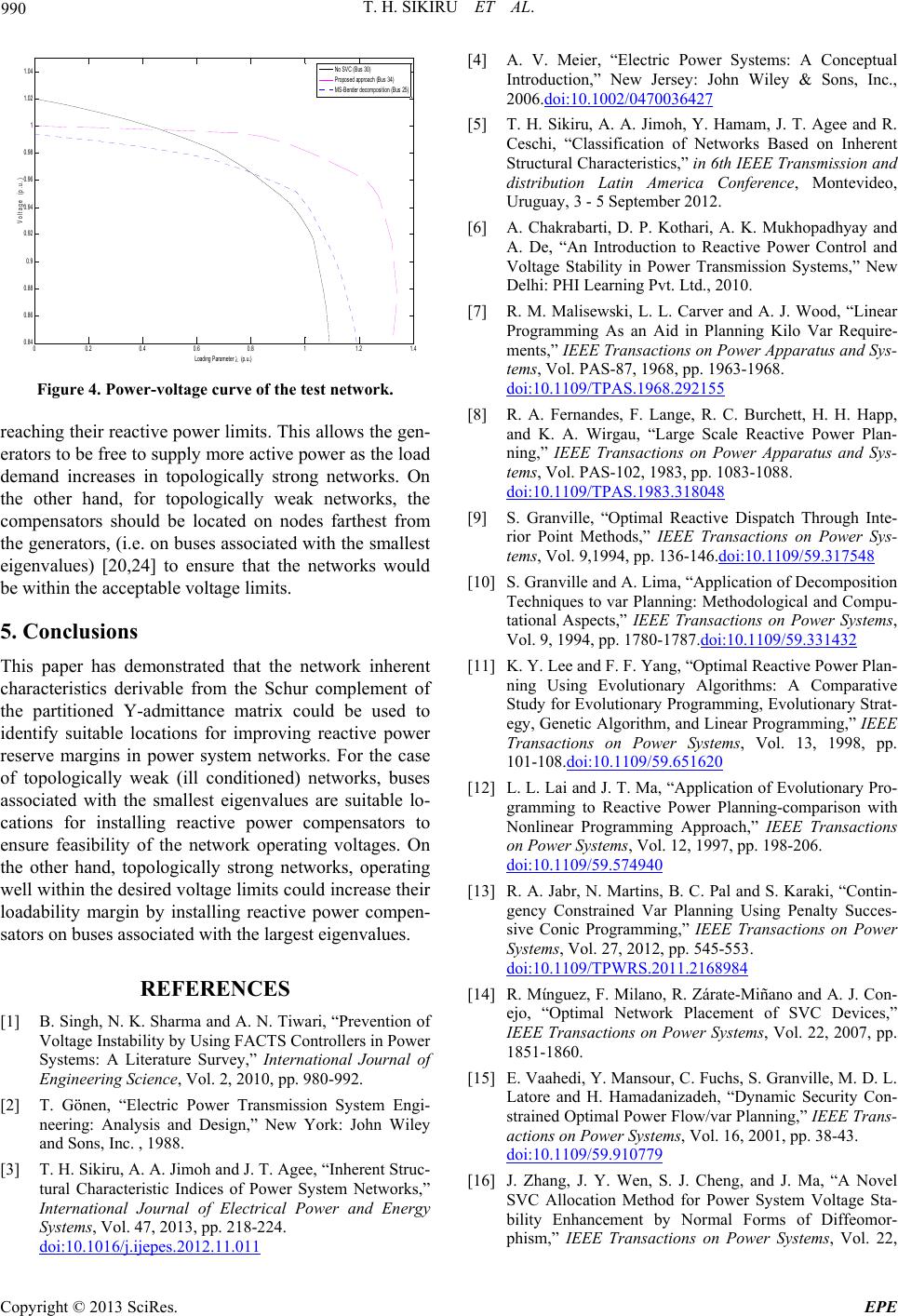
T. H. SIKIRU ET AL.
990
00.2 0.4 0.6 0.8 11.2 1.4
0.8 4
0.8 6
0.8 8
0.9
0.9 2
0.9 4
0.9 6
0.9 8
1
1.0 2
1.0 4
Loading Parameter
(p.u.)
Voltage (p.u.)
No SVC (Bus 30)
Pro po sed ap proa c h (B u s 34)
MS-B e nd er deco m po s it i o n (Bus 25)
Figure 4. Power-voltage curve of the test network.
reaching their reactive power limits. This allows the gen-
erators to be free to supply more active power as the load
demand increases in topologically strong networks. On
the other hand, for topologically weak networks, the
compensators should be located on nodes farthest from
the generators, (i.e. on buses associated with the smallest
eigenvalues) [20,24] to ensure that the networks would
be within the acceptable voltage limits.
5. Conclusions
This paper has demonstrated that the network inherent
characteristics derivable from the Schur complement of
the partitioned Y-admittance matrix could be used to
identify suitable locations for improving reactive power
reserve margins in power system networks. For the case
of topologically weak (ill conditioned) networks, buses
associated with the smallest eigenvalues are suitable lo-
cations for installing reactive power compensators to
ensure feasibility of the network operating voltages. On
the other hand, topologically strong networks, operating
well within the desired voltage limits could increase their
loadability margin by installing reactive power compen-
sators on buses associated with the largest eigenvalues.
REFERENCES
[1] B. Singh, N. K. Sharma and A. N. Tiwari, “Prevention of
Voltage Instability by Using FACTS Controllers in Power
Systems: A Literature Survey,” International Journal of
Engineering Science, Vol. 2, 2010, pp. 980-992.
[2] T. Gönen, “Electric Power Transmission System Engi-
neering: Analysis and Design,” New York: John Wiley
and Sons, Inc. , 1988.
[3] T. H. Sikiru, A. A. Jimoh and J. T. Agee, “Inherent Struc-
tural Characteristic Indices of Power System Networks,”
International Journal of Electrical Power and Energy
Systems, Vol. 47, 2013, pp. 218-224.
doi:10.1016/j.ijepes.2012.11.011
[4] A. V. Meier, “Electric Power Systems: A Conceptual
Introduction,” New Jersey: John Wiley & Sons, Inc.,
2006.doi:10.1002/0470036427
[5] T. H. Sikiru, A. A. Jimoh, Y. Hamam, J. T. Agee and R.
Ceschi, “Classification of Networks Based on Inherent
Structural Characteristics,” in 6th IEEE Transmission and
distribution Latin America Conference, Montevideo,
Uruguay, 3 - 5 September 2012.
[6] A. Chakrabarti, D. P. Kothari, A. K. Mukhopadhyay and
A. De, “An Introduction to Reactive Power Control and
Voltage Stability in Power Transmission Systems,” New
Delhi: PHI Learning Pvt. Ltd., 2010.
[7] R. M. Malisewski, L. L. Carver and A. J. Wood, “Linear
Programming As an Aid in Planning Kilo Var Require-
ments,” IEEE Transactions on Power Apparatus and Sys-
tems, Vol. PAS-87, 1968, pp. 1963-1968.
doi:10.1109/TPAS.1968.292155
[8] R. A. Fernandes, F. Lange, R. C. Burchett, H. H. Happ,
and K. A. Wirgau, “Large Scale Reactive Power Plan-
ning,” IEEE Transactions on Power Apparatus and Sys-
tems, Vol. PAS-102, 1983, pp. 1083-1088.
doi:10.1109/TPAS.1983.318048
[9] S. Granville, “Optimal Reactive Dispatch Through Inte-
rior Point Methods,” IEEE Transactions on Power Sys-
tems, Vol. 9,1994, pp. 136-146.doi:10.1109/59.317548
[10] S. Granville and A. Lima, “Application of Decomposition
Techniques to var Planning: Methodological and Compu-
tational Aspects,” IEEE Transactions on Power Systems,
Vol. 9, 1994, pp. 1780-1787.doi:10.1109/59.331432
[11] K. Y. Lee and F. F. Yang, “Optimal Reactive Power Plan-
ning Using Evolutionary Algorithms: A Comparative
Study for Evolutionary Programming, Evolutionary Strat-
egy, Genetic Algorithm, and Linear Programming,” IEEE
Transactions on Power Systems, Vol. 13, 1998, pp.
101-108.doi:10.1109/59.651620
[12] L. L. Lai and J. T. Ma, “Application of Evolutionary Pro-
gramming to Reactive Power Planning-comparison with
Nonlinear Programming Approach,” IEEE Transactions
on Power Systems, Vol. 12, 1997, pp. 198-206.
doi:10.1109/59.574940
[13] R. A. Jabr, N. Martins, B. C. Pal and S. Karaki, “Contin-
gency Constrained Var Planning Using Penalty Succes-
sive Conic Programming,” IEEE Transactions on Power
Systems, Vol. 27, 2012, pp. 545-553.
doi:10.1109/TPWRS.2011.2168984
[14] R. Mίnguez, F. Milano, R. Zárate-Miñano and A. J. Con-
ejo, “Optimal Network Placement of SVC Devices,”
IEEE Transactions on Power Systems, Vol. 22, 2007, pp.
1851-1860.
[15] E. Vaahedi, Y. Mansour, C. Fuchs, S. Granville, M. D. L.
Latore and H. Hamadanizadeh, “Dynamic Security Con-
strained Optimal Power Flow/var Planning,” IEEE Trans-
actions on Power Systems, Vol. 16, 2001, pp. 38-43.
doi:10.1109/59.910779
[16] J. Zhang, J. Y. Wen, S. J. Cheng, and J. Ma, “A Novel
SVC Allocation Method for Power System Voltage Sta-
bility Enhancement by Normal Forms of Diffeomor-
phism,” IEEE Transactions on Power Systems, Vol. 22,
Copyright © 2013 SciRes. EPE